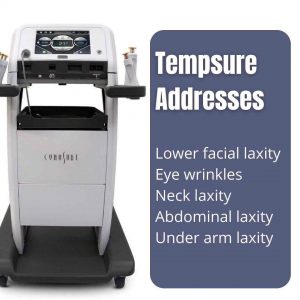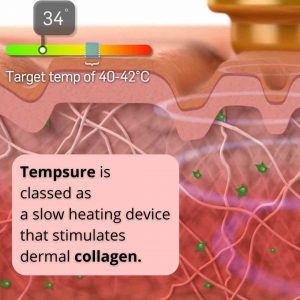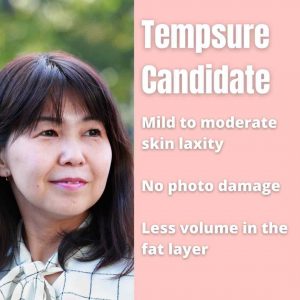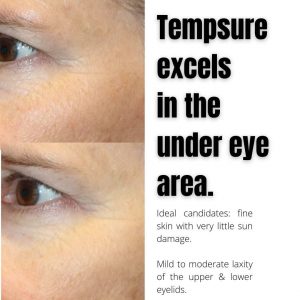Tempsure; At A Glance
- Best Results2- 4 sessions
- Treatment RecoveryNil
- Procedure Time40 min
- Skin SpecialistDermal Therapist
- Duration of Results1-3 + years
- AnaestheticNil, Painless
- Back to WorkImmediately
- Cost$$
Tempsure Skin Tightening
Tempsure is a non-surgical modality of improving skin tone & laxity. This treatment has no downtime and is well tolerated by all patients. It uses RF or radiofrequency based energy to contract and stimulate dermal collagen. This can provide skin tightening around the eyes, cheeks, jowls & neck. This form of skin tightening uses low heat over a longer period, compared to intense heating from HIFU (Microfocused Ultrasound/ High Intensity Focused Ultrasound).
FactsFacts on Tempsure RF Skin Tightening
- Skin tone describes the elastic recoil of skin
- Tone decreases with age, whilst skin sagging & laxity increases with age
- Factors such as sun exposure, smoking & weight loss can worsen skin tone
- Skin tone can be improved with surgical & non-surgical methods
- Non-surgical methods include radiofrequency, HIFU & thread lifting
- Radiofrequency devices include Tempsure & Thermage
- RF skin tightening is suited in cases of mild to moderate laxity
What skin conditions can Tempsure address?
This treatment is best for mild to moderate skin sagging & laxity invoicing the jowls, cheeks, eyes & neck area. This treatment is also an effective way to prevent skin laxity.

How long does it take to notice results?
Immediately after the procedure a phenomenon known as ‘immediate collagen contraction’ occurs. This looks awesome as it seems that skin tightening is achieved within a few minutes of the procedure as heat contracts collagen. Over the next few days your elasticity will return to normal, however over the next 6-12 weeks more collagen will form. Most patients will notice a difference during this time, however a series of treatments will be required for optimal outcomes.
How long is the procedure?
Each Tempsure treatment takes between 50 – 80 minutes to perform. Treatments are comfortable, with no downtime.

Is RF skin tightening painful?
No, not in this setting. I used to have Thermage which is another form of RF skin tightening- popular in Asia. I found that most patients did not tolerate this device and hence in many cases I could not use it to the full potential. Tempsure on the other hand is very comfortable, this means my therapist & nurses can actually finish the treatments. The before and after results, together with the comfort levels was an easy decision to swap RF systems.

View our Treatment Gallery
How many sessions will I require?
As a guideline 2-5 sessions spaced 4- 8 weeks apart. The number of sessions to achieve skin tightening depends on your skin quality (less sun damage the better), your age (younger the better), your ethnicity (generally ethnic skin patients do better due to increased collagen density), the location (eyelids less treatments than neck), lifestyle factors, genetic factors and your expectations.

Results can be seen as early as one session, however due to the gentle heating of collagen over time, a series of treatments are recommended.
What other methods do I employ to tighten skin?
There are other methods that I employ to tighten skin, based upon the degree of laxity and clinical presentation.
Lasers can help tighten the dermis, however their main role is to improve skin quality. Lifting or so called ‘laser lifts’ is a bonus and not an expected outcome of the procedure. Refer to before & after photos to understand more.

Thread lifts can be effective in some patients. Suitable candidates should have enough facial fat to reduce ‘thread show’. Conversely patients with excessive jowls are not great candidates as threads have a limitation on the weight of tissue they can lift. I often combine threads with devices including lasers, RF & HIFU- Ultherapy.

Surgical face lifting is a low downtime procedure that can improve skin tone in suitable patients.
Liquid face lifting is a term to describe strategic placement of dermal fillers to volumize key areas. This displacement in volume can provide secondary ‘lifting’ in areas such as the cheeks, jowls and neck.
Vampire face lifts or PRP has been popularised by the media. This technique involves the use of microneedling prior to the use of autologous blood products (the patient’s own blood). In therapy platelets produce growth factors that synergistically improve collagen quality when combined with microneedling. This treatment can marginally improve skin quality, but it does not provide any significant lifting.
Lighting could be better, however in the after photos the better light reflex & luminosity reflects the better skin quality following treatment
.
👉The Procedure: Jessner TCA peel & low density CO2 in key vectors in addition to 60 PDO threads in vectors, RF at 3.5 mm. One session only. Predicable non-surgical skin tightening follows a complex algorithm based on clinical features, genetics, ethnicity, goals, equipment, & more
.
👍🏻The logic: Stimulation of all layers from the mid to superficial dermis (peel), deeper dermis (low density but high power CO2), hypodermis (RFM) & hypodermis & fibroseptal network (PDO threads)
.
⏭Next stage: dermal fillers to further improve the outcomes
.
🙄Suitable patients: mild to moderate laxity (leaning towards mildish). For lighter types, I prefer lasers or medium to deep peels, for darker skin types I use RF devices (RFM, NuEra, Pelleve) & HIFU
.
🎬Action: For an opinion on threads & skin tightening book a consult with Katie or Alison at Cutis Dermatology
.
😎Davin Lim
Dermatologist
Brisbane🇦🇺
AU
.
#lskintightening #HIFU #pdothreads #threadlifting #skinlaxity #brisbanedermatologist #dermatology #skinscience #facelifting #nonsurgicalfacelift #threadlift #mintpdo #mintthreads #pdothreadlifting
Skin tightening with lasers & threads🔫🧵🪡
.
👉Logic: Ablative lasers (erbium + CO2) can provide immediate collagen contraction. This can firm up skin & improve skin quality. Threads, in particular PDO threads can cause fibrosis, synergically stimulating collagen production. This can further tighten skin
.
👊🏻🤜🏻🥊Combinations: We have just started to use a combination of laser (superficial), threads (dermal-subdermal) & deeper RF timed appropriately to provide immediate, delayed & prolonged collagen production. The results, to date have been exceptional (to a point where I’m seriously surprised)
.
👍🏻Indications: mild to moderate laxity. The amount of laser vs threads vs RF & the timings varies according to age, skin quality (amount of photodamage), dermal thickness, skin type & other factors. Patient selection is critical to getting a good outcome
.
👉Next step: Adding collagen stimulating fillers in appropriate dilutions to further compound results
.
🧵Action: to see if you are a candidate for this procedure, book an appointment with the senior nurses Alison & Katie at Cutis Dermatology
.
😠BTW Cutis Derm IG page is still hacked, so don’t fall for the bitcoin sell
.
😎Davin Lim
Dermatologist
Brisbane🇦🇺
#drdavinlim #dermatologist #skintightening #PDOthreads #mintthreads
#threadlifting #threads #laserskinrejuvenation #skinrejuvenation #skinscience #brisbanedermatologist
Based upon probability and not possibility
.
👉🏾👉🏽Darker skin: more melanin, more reactive melanocytes, hence more prone to dyschromia / pigmentation. Pico lasers work well by reducing pigment and at the same time remodel collagen with little downtime (if at all). Collagen bundles are thicker and more protected from UV due to increased pigment. Collagen producing cells, or fibroblasts are larger, more numerous & more vigorous in their response to heat, hence why skin tightening devices work better in darker skin 💯
.
👉👉Lighter skin: more suitable for ablative laser, high pass fractional lasers & medium to deep peels. Darker skin type will PIH with above. Anecdotally some lighter skin types do extremely well with skin tightening devices such as #HIFU, #Ultherapy, Ultraformer, RF devices including RF Microneedling, Tempsure, Pelleve, Thermage etc… These skin types include east/mid Eurpeans, think Czech, Russian especially if photoprotected most of their lives (less collagen breakdown/elastosis)
.
😎Dr Davin Lim
Dermatologist
Brisbane,🇦🇺
.
#skintightening #skintone #antiaging #skintreatment ##ultraformer #Tempsure #thermage #davinlim #dermatologist #dermatology #collagen
Laser resurfacing can give good results. #collagen remodelling can be somewhat predictable, however the ‘lift; in this patient is quite remarkable as collagen contraction has reduced her jowls. This is an exception rather than the rule
.
.
🔬Skin Science: Ablative lasers are still relevant in #dermatology. They can be used to treat derm conditions including actinic cheilitis, sBBCs, IEC-Bowen Disease, solar keratosis, seb ks, seb hyperplasia as well as shallow acne scars. In this case I used both erbium & CO2 fully ablative lasers
.
.
👉👀Concept: Lasers can improve skin quality & provide collagen contraction. Lasers do NOT address volume. For best results it is the balance between improving skin quality, skin tightening (energy devices vs surgical), & volume replacement (filler or fat)
.
.
😎Dr Davin Lim
@drdavinlim
@cliniccutis
Brisbane🇦🇺
.
.
#laserdermatology #dermatologist #dermatologistbrisbane #skinrejuvenation #laserresurfacing #skinscience #rejuvenation #davinlim #drdavinlim #antiaging #laserrejuvenation #co2lasers #erbiumlaser
What does the balance between achieving good skin texture, tone & volume mean?
Apart from sagging or decreased skin ‘tone’ one should be mindful of other aspects that portray great skin, namely skin quality (palate of the skin) & volume. In many cases, addressing volume changes (such as the jawline area, mid & lateral cheeks) we can improve laxity. How? Volume displaces loose skin.

Can you have too much improvement in skin tone / skin laxity?
Yes, and it does not look pretty. Remember the old fashioned ‘scared cat’ look of the 90s, namely deep plane over the top face lifts? Yes, this is when volume displacement is overlooked. For a natural look, one must combine skin excisions with either fat grafting or dermal fillers. Balance is the key.
How do I know if Tempsure is right for me?
My team and I are extremely selective as to who we will treat with Tempsure and other skin tightening devices. Why? Because we are results driven. Not every patient is suitable for this treatment. I employ other methods to lift skin, including Ultherapy, Thermage, RF microneedling, dermal fillers, lasers, thread lifts & even surgery.
For a consultation to see if Tempsure is right for you, book in for a consultation with one of my clinical therapists @cutis_dermatology.
Davin’s Take on Tempsure
Having had & performed skin tightening over the years, here is my take on the whole topic.
Firstly, you need to be a good candidate for skin tightening to work. How so? Your dermis should have a good thick layer of collagen, never mind if it is lax, I will go into this a little later. Sun damage or elastosis under the microscope shows broken collagen, much akin to broken springs, it is not going to contract as well as if the springs are intact.

How does ethnicity come into play? Dermatologists are well aware of ethnic variation of skin physiology. Darker skin patients are much less likely to develop skin cancers, on the flip side they are more likely to have hyperpigmentation & keloid scarring. Ethnic patients also have a thicker dermal layer that has very little in the way of broken collagen. Sagging is thus a value of lax or stretched collagen (AKA Springs). Hence with heating of the dermis, collagen in ethnics are more likely to contract, providing skin tightening. This is why skin tightening devices are popular in Asian & Middle Eastern countries- because they have a higher (not absolute) chance of working!

So, if one has significant sun damage, is skin tightening an absolute lost cause? No, once again speaking generally, the chances of ‘no downtime’ skin tightening will not live up to your expectations. There are however more predictable ways to tighten skin. The gold standard is a deep plane facelift, followed by a short scar or mini-S-facelift. Nothing comes close in the context of severe laxity. Threads? Yes, barbed threads or conical thread lifting (eg. Silhouette or Mint) can be effective. I am tending to use them less frequently as the results rarely last longer than a year. The newer monofilament MINT (Minimally Invasive Non-Surgical Threads) are better, especially when combined with heating devices.
Ablative lasers or deep chemical peels can improve the quality of collagen via a process called neocollagenesis. These treatments ablate & coagulates old elastosis, tightening up coils & forming new ‘springs.’ The downside? Downtime. For predictable results, expect a downtime of at least 8-10 days, depending on the depth of ablation. CO2 lasers have a longer recovery, however they provide more collagen tightening than erbium.

Another treatment that I utilize for skin laxity is off label collagen stimulating fillers, or hyper diluted Radiesse (Calcium Hydroxyl Apatite). This bespoke skin hydrating treatment can be mixed with saline & lidocaine, concentration depending on the amount of atrophy, wrinkles, sun damage & location. For patients who have a significant amount of sun damage, I find this method of dermal filling more predictable than with energy devices (Tempsure, Ultherapy, Ulthera, Thermage, Pelleve).

